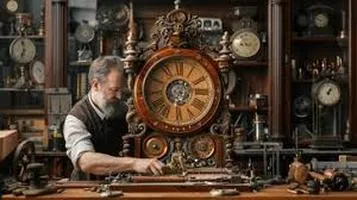Antique Clocks: Timeless Treasures of Art and Engineering
Antique clocks are exquisite timepieces that not only serve as functional objects but also as historical artifacts, reflecting the craftsmanship and design sensibilities of their era. Ranging from the intricate detailing of 18th-century French mantel clocks to the robust construction of early American tall case clocks, these pieces capture the essence of bygone times. Often made from fine woods, metals, and adorned with ornate carvings or enamel work, antique clocks are celebrated for their mechanical ingenuity, featuring movements driven by weights, springs, or pendulums. Collectors and enthusiasts value antique clocks for their aesthetic appeal, historical significance, and the nostalgia they evoke. Whether showcased in a private collection or a museum, these clocks offer a timeless glimpse into the evolution of horology and design.

Antique clocks hold a unique place in the realm of collectibles, combining the precision of engineering with the aesthetic beauty of art. From the majestic grandfather clocks that stand as sentinels in grand hallways to the intricate mantel clocks that grace our living rooms, these timepieces offer more than just the ability to tell time; they represent history, craftsmanship, and an era when timekeeping was both a science and an art.
One of the most compelling aspects of antique clocks is their craftsmanship. Unlike modern clocks, which are often mass-produced and made from synthetic materials, antique clocks are characterized by their meticulous handmade construction. Each component, from the gears and springs to the hands and dials, is crafted with precision and care. The materials used, such as brass, wood, and enamel, add to their enduring allure. The artistry involved in their creation is evident in the intricate designs that adorn their cases and faces, often featuring elaborate carvings, inlays, and gilding.
The history embodied in antique clocks is another aspect that draws collectors and enthusiasts. These timepieces serve as tangible connections to the past, offering a glimpse into the technological advancements and aesthetic preferences of different eras. For instance, an 18th-century French mantel clock might feature Rococo designs with flowing, ornate patterns, while a 19th-century British longcase clock could reflect the more restrained elegance of the Victorian era. Each clock tells a story not just of its own creation but of the period in which it was made, offering insights into the cultural and social contexts of its time.
One cannot discuss antique clocks without mentioning their mechanical ingenuity. The internal mechanisms of these clocks, often visible through glass panels or upon opening the case, are marvels of early engineering. The escapements, pendulums, and winding mechanisms all work in harmony to measure time accurately, a testament to the skill of the clockmakers. The complexity of these mechanisms can be awe-inspiring, and for those with a technical inclination, understanding how these components work together can be a deeply satisfying experience.
However, owning an antique clock is not without its challenges. These timepieces require regular maintenance to keep them in working order. Unlike modern clocks, which might need a simple battery replacement, antique clocks often require the expertise of a skilled horologist to clean, repair, and adjust their mechanisms. This can be a costly and time-consuming process, but for many, it is a labor of love. The joy of hearing the steady tick-tock of a well-maintained antique clock, or the melodious chime marking the hour, can make the effort well worth it.
In terms of investment, antique clocks can be a wise choice, provided one has a keen eye for quality and authenticity. The market for these timepieces is robust, with certain styles and makers commanding high prices at auctions and among collectors. Well-preserved examples from renowned clockmakers such as Thomas Tompion, John Harrison, and Abraham-Louis Breguet can fetch substantial sums. However, it is crucial to conduct thorough research and, if possible, consult with experts before making a purchase, as the market is also rife with reproductions and forgeries.
The aesthetic versatility of antique clocks also makes them desirable for interior decor. Whether one’s home is furnished in a traditional style or boasts a more eclectic, modern aesthetic, there is likely an antique clock that will complement the decor. A sleek Art Deco clock can add a touch of vintage elegance to a contemporary space, while a rustic cuckoo clock can bring a sense of charm and whimsy to a country-style kitchen. The presence of an antique clock can serve as a focal point in a room, drawing the eye and sparking conversations.
Moreover, antique clocks often become cherished family heirlooms, passed down through generations. They are imbued with sentimental value, representing not just the passage of time but the continuity of family traditions and memories. The act of winding the clock, adjusting its hands, and listening to its chimes can become a ritual that connects us to our ancestors and to the rhythms of life.
In conclusion, antique clocks are much more than mere instruments for keeping time. They are embodiments of history, art, and engineering. Their allure lies in their craftsmanship, their stories, and their mechanical marvels. While they require care and expertise to maintain, the rewards of owning an antique clock are manifold. For collectors, historians, and anyone with an appreciation for fine craftsmanship, antique clocks offer a timeless journey through the ages, marking not just the hours and minutes, but the enduring beauty of human ingenuity.






